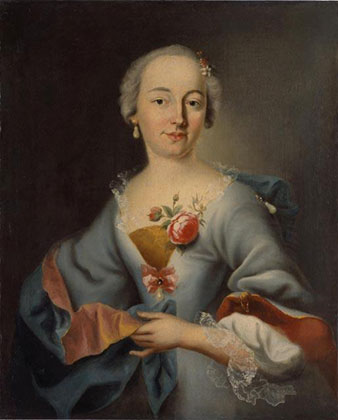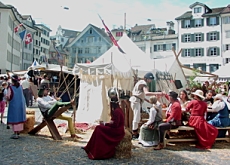Women seek to reclaim historic guilds role

An exhibition has unearthed evidence of the historic role of women in Zurich's guilds that contrasts with their present exclusion from the men-only clubs.
Traditionalists have rejected a campaign to allow women back into the guilds and play a full part in the famous Sechseläuten festival. But new research lends more ammunition to the women’s cause.
Zurich’s guilds used to play a central role in the city’s economic and political fortunes until power was stripped away in the 19th century. The trade institutions now serve only a ceremonial function, but many women feel that is no reason to be left out in the cold.
An exhibition currently running in Zurich entitled Women, Guilds and Men’s World traces the contribution women have made to the guilds over the centuries. It has been timed to commemorate the building of the Meisen guild house 250 years ago – by two women.
Zurich’s 13 original guilds came to power in the city in 1336 when nobleman Rudolf Brun led a “craftsmen’s revolution” that ousted local politicians. They ran Zurich for centuries before their stranglehold was broken during a series of political upheavals that started some 200 years ago.
At the height of the guilds’ power, wives and unmarried daughters of male members were permitted to join the same institutions, although they had no place in the decision-making processes.
Some also made more of a name for themselves, such as those who designed and made a fashionable and commercially successful line of hats in the 18th century.
When the Meisen guild decided to relocate its headquarters, two women undercut local male builders to win the contract in 1757.
The gradual freezing-out of women came to a head in the 19th century when they were denied access altogether. This happened at around the same time that the traditional guilds lost their political influence and various city neighbourhoods formed a wave of new guilds.
Sechseläuten procession
This fact has been a bone of contention for women for years, particularly during the annual spring Sechseläuten festival – a landmark Zurich event that marks the start of the season with a procession through the streets culminating in the symbolic explosion of the Böögg snowman.
A compromise was reached in 2000 that allows women to hold their own procession before the main Sechseläuten event using a different route to the men.
One group of women formed their own unofficial guild in 1989 known as the Fraumünster guild, named after a Zurich cathedral. But the guild has not been officially accepted because it does not represent a recognised trade.
“The men used to say that it was traditional for the guilds not to take women, but the exhibition proves that argument wrong,” Fraumünster guild spokeswomen Jeannette Derrer told swissinfo.
“Now they say that the procession would be too long if women take part. We are not very happy about this and argue that it would be good for everyone if we could play a full role.”
Thaw in sight?
The argument reached an impasse a few years ago when the guild heads became annoyed at the confrontational tactics used by women. But relations between the two sides have thawed enough recently to at least entertain the thought of women being let back in.
“It is a very difficult question and in the past the women did not present their argument in an acceptable way,” Zurich guilds spokesman Andreas Weidmann told swissinfo.
“But there has been a change for the better in the relationship between the men and women recently that could result in a big change in the way of thinking. It is possible that in five or ten years we could see real change.”
swissinfo, Matthew Allen in Zurich
Zurich has 26 guilds representing a variety of trades and local communities.
One of the original 13 guilds, the Society of Constables, was formed by local knights and nobility, but was forced to welcome undesirable trades such as executioners and beggars in the 15th century.
A law in 1490 required every tradesperson to enter a guild in order to conduct their business.
As Zurich was growing in size it welcomed new citizens, but by the 16th century the city was so large it stopped the right to buy citizenship.
The invasion of Napoleon’s armies into Switzerland in 1798 saw the beginning of the end for the guilds’ old powers, with the Swiss constitution of 1848 driving home the final nail.
The Sechseläuten festival takes place every April in Zurich to mark the end of winter and to welcome in spring. The name means “six o’clock bells”, signifying the high point of the ceremony at 6pm sharp. The festival dates back to the 1830s.
Guild members dress up in traditional costume and parade through the streets towards one of the city’s main squares.
There a snowman, called the Böögg, representing winter with its head stuffed full of fireworks, is set alight. Superstition has that if the Böögg’s head explodes quickly it will signify a fine summer.
A version of the festival also took place in London in 2003 at the Lord Mayor’s Show.

In compliance with the JTI standards
More: SWI swissinfo.ch certified by the Journalism Trust Initiative


You can find an overview of ongoing debates with our journalists here. Please join us!
If you want to start a conversation about a topic raised in this article or want to report factual errors, email us at english@swissinfo.ch.